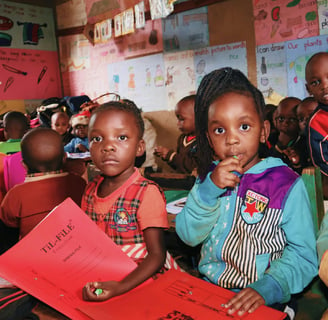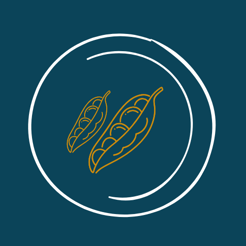On Transformations
From Soil to School: When Farming Futures Depend on Children
4/24/20254 min temps de lecture


The Question Beyond the Harvest
Farming is often seen merely as the art of cultivating crops. Yet the true measure of agricultural success may not be found solely in yield or quality, but in the promise of a future. When we observe the fields of Madagascar—rich with vanilla, spices, and potential—we’re compelled to ask: what becomes of that promise once the harvest is complete? In many communities, even as the land yields its bounty, schools struggle. The gap isn’t in the soil but in the classrooms where young minds ought to be nurtured. Far too often, children must forgo education—whether due to the lack of basic supplies or the burden of domestic labor—to help support their families. The question then becomes not just how we farm but what kind of future our farming practices can help create.
Observations from the Field
While sourcing products directly from Madagascar, we witnessed both the beauty of sustainable agriculture and the challenges faced by local communities. In quiet rural settings, farmers work with passion and resilience. Yet beyond the cultivated fields lie classrooms that lack essentials—worn-out textbooks, missing stationery, and sometimes no supplies at all. There are girls who miss school during menstruation because sanitary supplies are out of reach. There are families where children are pulled out of school to assist with harvests. These overlooked nuances challenge us to consider a broader view: if the land is fruitful but the future generation is starved of opportunities, what are we truly cultivating?
Somesha Mada: Our Response
In light of these persistent gaps, we quietly embarked on a side initiative known as Somesha Mada. This project did not emerge from grand strategies or glossy CSR objectives; it grew out of genuine observation and care. When we saw that exceptional produce existed alongside empty classrooms, it became clear that the value generated on the farm needed to be reinvested locally. Somesha Mada began modestly—with notebooks, pencils, sanitary towels, and other small but meaningful supplies. Not as a token of charity, but as a recognition that a child’s education and dignity are as critical as the quality of a harvest. These actions represent our belief that every investment in the next generation contributes quietly yet substantially to community resilience.
Guarding Against Child Labour
Education serves as a vital safeguard not only for nurturing future leaders but also for protecting children from exploitation. In many parts of the supply chain, from the fields to processing facilities, vulnerable children risk being drawn into labor due to economic hardships. By supporting education programs, we help ensure that children remain in classrooms rather than on farms or in export industries. When schools are equipped and communities are supported, families are less pressured to send their children into labor. Instead, children can spend their time learning and growing—a shift that diminishes the likelihood of child labour permeating our food supply chains. This protective measure is essential for building a more ethical, sustainable system overall.
Interconnected Futures: The Broader Picture
Holistic farming goes beyond crop rotation and sustainable practices. It recognizes that the benefits of agriculture are deeply entwined with the well-being of the communities who make it all possible. A successful harvest is not just a milestone for the farmer; it should ripple throughout the village—enhancing education, healthcare, and future opportunities. By ensuring children have access to proper educational resources and by safeguarding them from exploitative labor practices, we help create a foundation where a more skilled, informed, and resilient generation can emerge. The pathway from soil to school is not a simple transaction but a cycle where agricultural prosperity supports community development—and vice versa.
Reflecting on the Challenges and Possibilities
The realities we witness in rural Madagascar are neither unique nor easy to solve. Exceptional export quality and modern supply chains often coexist with local deficiencies in education and child protection. There is a subtle irony when premium products are celebrated abroad while the children who helped produce them are denied the chance to learn and dream. This imbalance challenges us to think critically about what true progress means. It is a call to measure success not just by market figures or the brilliance of export products, but by how many children return to school, how many classrooms are re-equipped, and how resilient communities become as a result. We do not claim to have all the answers—Somewhat Mada is still evolving. Yet we believe that every small contribution, every pencil donated, and every classroom provided is a step toward a future where farming yields more than produce; it yields hope.
The Long-Term Vision
There is no silver bullet for the challenges that straddle agriculture and education. The change we envision is gradual, reflecting a continuous effort rather than a momentary fix. It does not shout from the rooftops but is quietly affirmed in every child who steps into a well-equipped classroom, every parent who sees a future beyond immediate hardship, and every community that begins to thrive. Our vision does not deny the difficulties inherent in the current system. It acknowledges that transforming deep-seated practices is neither swift nor simple. However, it is based on the understanding that thoughtful actions—supporting education, reducing child labour, and reinvesting in community development—can create enduring ripples over time. Holistic farming, for us, means more than just excellent crop yields. It is about nurturing an ecosystem where the prosperity derived from the soil extends to every facet of life—from the classroom to the family home. It is a commitment to ensuring that the benefits of agricultural success reach the next generation.
Concluding Thoughts
In the end, the journey from soil to school is much more than a pathway—it is a reflection of our priorities. It challenges us to consider whether every profit made and every export completed might also help build a society that safeguards its children and secures their future. Somesha Mada is our modest attempt to reconnect the threads of agriculture, education, and community well-being. It is not a comprehensive solution, but a measured and ongoing effort to ensure that sustainable trade also champions the rights of every child to learn, grow, and contribute to a better tomorrow. Because ultimately, true sustainability is measured not only by what the land produces but also by the potential it nurtures—one classroom, one child, and one hope at a time.
CONTACT US
The Waterfront Karen, Lang'ata Road, Nairobi.
contact@rickmalmerchants.com
+254795977490
Let’s be friends :
Mo - Fri: 9am - 6pm
© 2025 Rickmal Merchant Ltd.
All rights reserved
